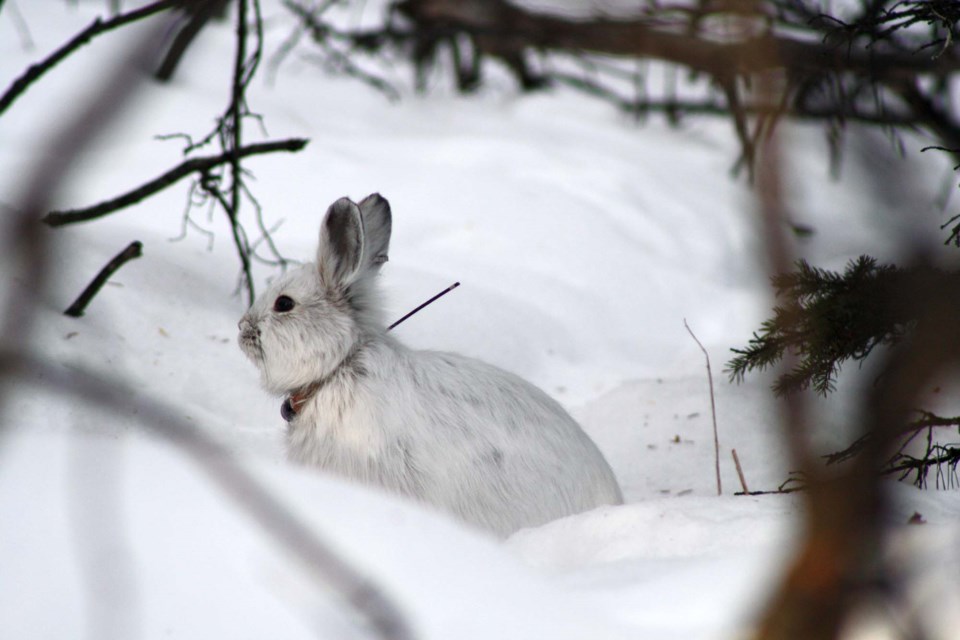Snowshoe hares are becoming easier prey for coyotes due to global heating, and that could have far-reaching consequences for the boreal forest, according to a recent University of Alberta study.
U of A researcher Michael Peers published a study in Nature Climate Change last September on how climate change has made snowshoe hares more vulnerable to coyotes.
Snowshoe hares and white-tailed jackrabbits are both found in the Edmonton and St. Albert region, said U of A biologist Stan Boutin, a co-author on this study. Snowshoe hares frequent dense bush and forest, and tend to jump with their back feet and land with their front. Jackrabbits are twice the size of snowshoe hares, and they hang around streets and open fields, bounding about like kangaroos.
The biggest difference is in their feet, Boutin continued. A snowshoe hare has hind feet that are much bigger and wider than a jackrabbit’s, enabling it to float on the surface of thick snow.
Snowshoe hares are a keystone species in the boreal forest in that many different animals eat them, said Peers, who is now a postdoctoral fellow at Memorial University in Newfoundland and Labrador.
Previous studies have found that global heating had reduced the amount of snow on the ground in spring and autumn, making hares more vulnerable to predators as they spend more time on brown backgrounds while wearing white winter coats. He and his team wanted to test if snow depth also affected hare numbers.
CSI Bunny
Peers and his team tracked 321 snowshoe hares over four winters in the Kluane Lake region in the Yukon. This involved fitting them with tracking collars that sent a signal whenever the hares didn’t move for four hours and were therefore likely dead. Team members then tracked down the collars to determine what had killed the hares.
“That was definitely the best part; it was totally CSI,” said Peers, referring to the popular forensic investigation show.
You could tell what killed the hare based on the scene of the crime, Peers said. A lynx would leave the pelt and guts behind in a neat pile, while a coyote was messier – picture a dog getting into a bag of kibble – and would often cache the head or other body parts nearby.
The team found that a hare’s chance of survival changes with snow depth and hardness. Snowshoe hares are 97 per cent likely to survive 30 days when the snow depth is more than 60 cm, but that statistic drops by 10 per cent if there is just 25 cm of snow. That survival rate falls to 77 per cent if the snow is both shallow and soft.
Most of these changes are due to coyotes. Hares faced the least risk from coyotes on deep snow, as they could hop along the surface while the coyotes had to flounder in the depths, Peers explained.
They faced the most risk when snow was shallow and soft, as those conditions allowed the coyotes’ feet to touch the ground, giving them speed and traction. Snow depth did not affect a hare’s risk from a lynx, as lynxes had the big feet needed for all snow conditions.
Snow depth at the test site has fallen about 15 cm per decade in the last 30 years due to climate change, which has resulted in warmer temperatures, more rain, and less snow, Peers said. If this trend continues (as was projected for much of Alberta), Canada would see a significant decline in its hare population, with knock-on effects on hare predators.
“It’s going to be a completely different ecosystem,” Peers said.
Boutin said this study should serve as a wake-up call for the impacts of climate warming, the effects of which have also been seen on woodland caribou up north. While reducing greenhouse gas emissions would help, Boutin said it would be tough to protect snowshoe hares from warming, as creating a protected area for them won’t keep out a changed climate.
The study is available at go.nature.com/385NRTi.




